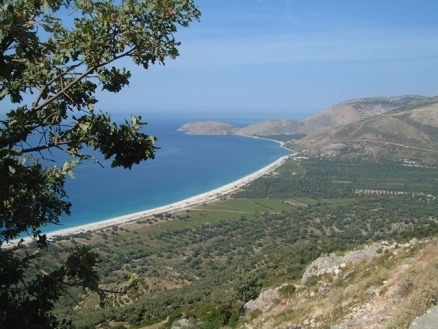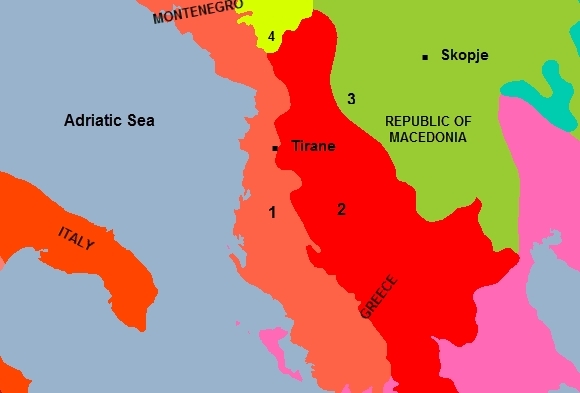Ecoregions of Albania
Ecoregions of Countries Collection 
Albania has four major ecoregions:
- Illyrian deciduous forests
- Pindus Mountains mixed forests
- Balkan mixed forests
- Dinaric Mountains mixed forests
Contents
Illyrian deciduous forests
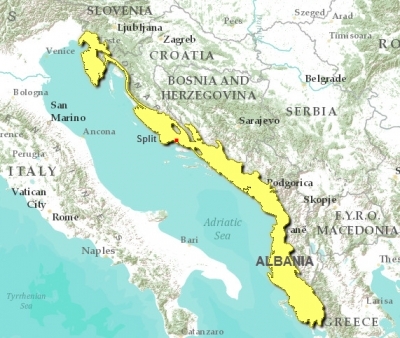 These forests encompass coastal areas on the eastern coast of the Adriatic Sea. This ecoregion is actually comprised of three distinct forest types, two of which are broadleaf and one of which is a mixed conifer/broadleaf Plant community. The region has a relatively high floral endemism rate with many relict and narrow range species. Faunal diversity is high, and a number of IBAs (Important Bird Areas) and threatened SPECs (Species of European Concern) are found within the region. Illegal logging, illegal hunting, and uncontrolled plantharvesting have destroyed extensive forest areas that have been relatively intact until recently.
These forests encompass coastal areas on the eastern coast of the Adriatic Sea. This ecoregion is actually comprised of three distinct forest types, two of which are broadleaf and one of which is a mixed conifer/broadleaf Plant community. The region has a relatively high floral endemism rate with many relict and narrow range species. Faunal diversity is high, and a number of IBAs (Important Bird Areas) and threatened SPECs (Species of European Concern) are found within the region. Illegal logging, illegal hunting, and uncontrolled plantharvesting have destroyed extensive forest areas that have been relatively intact until recently.
The mountain ranges of this region have historically held low human populations, and tall forests still prevail widely throughout; however there were pockets of intense exploitation in antiquity. For example, the Roman Diocletian's Palace in present day Split, Croatia is a monument to the population intensity and local resource exploitation circa 200 AD. This edifice is the largest extant Roman palace outside Italy, and continued to thrive continuously through the Dark and Middle Ages. A significant number of pristine large forest stands remained quite untouched until very recently. Rapid and intense forest degradation in the form of illegal logging, pollution, and fire took place during the recent Balkan conflicts that led to the division of the Former Yugoslavia into a number of independent republics
Pindus Mountains mixed forests
 Source: WWF The Pindus Mountain range, extending across the countries of Greece, Former Yugoslav Republic of Macedonia (FYROM), and Albania, contains high, steep peaks, dissected by many deep canyons and other karstic landscapes. At higher elevations the forest is composed of conifer species, while at lower altitudes, mixed broadleaf species predominate. The region has an outstanding rate of floral endemism. Surprisingly, the Mediterranean’s forests are second only to the tropical Andes worldwide in richness of endemic plants, and this ecoregion’s rate of endemism can exceed 35%. A large number of endemic and restricted range plant species are threatened with extinction. Brown bear (Ursus arctos), wolf (Canis lupus), and jackal (Canis aureus) populations persist in these mountains. Threats to the ecoregion are the result of a wide array of human activities. Socio-economic and political instability in the northern part of the ecoregion contributes to pressures on the region’s biodiversity.
Source: WWF The Pindus Mountain range, extending across the countries of Greece, Former Yugoslav Republic of Macedonia (FYROM), and Albania, contains high, steep peaks, dissected by many deep canyons and other karstic landscapes. At higher elevations the forest is composed of conifer species, while at lower altitudes, mixed broadleaf species predominate. The region has an outstanding rate of floral endemism. Surprisingly, the Mediterranean’s forests are second only to the tropical Andes worldwide in richness of endemic plants, and this ecoregion’s rate of endemism can exceed 35%. A large number of endemic and restricted range plant species are threatened with extinction. Brown bear (Ursus arctos), wolf (Canis lupus), and jackal (Canis aureus) populations persist in these mountains. Threats to the ecoregion are the result of a wide array of human activities. Socio-economic and political instability in the northern part of the ecoregion contributes to pressures on the region’s biodiversity.
According to historical data, at the end of the Antiquity, it appears that the Pindus mountain ranges had a very low human population, and tall forests prevailed widely throughout. No evidence exists of a significant timber trade or intensive logging in the Pindus until the eighteenth century. Rapid landscape changes occurred between 1800-1870 including overgrazing, firewood collection, and agriculture, during a period of important population growth and political instability. Pressure on forests continued until after 1950, leading to accelerated deforestation and soil erosion. Nevertheless, the Pindus mountain ranges still host significant old-growth forest stands, mainly related to inaccessible high mountain slopes and canyons (i.e. the Aos River canyon).
Balkan mixed forests
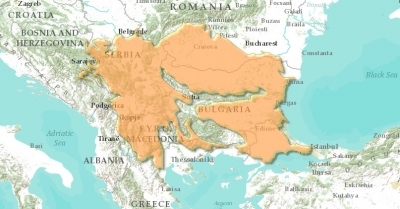 The Balkan mixed forests are found at the east of Albania and extend beyon the national boundary of Albania. The ecoregion covers much of Bulgaria and bordering countries, excluding the Rodope Mountains. The vegetation of this ecoregion, especially that of the forests and grasslands, is Central European in character.
The Balkan mixed forests are found at the east of Albania and extend beyon the national boundary of Albania. The ecoregion covers much of Bulgaria and bordering countries, excluding the Rodope Mountains. The vegetation of this ecoregion, especially that of the forests and grasslands, is Central European in character.
The diversity of flora and fauna is relatively high compared to the rest of Europe and there are a high number of endemic plant species. Mixed oak forests are characteristic, with Quercus frainetto as the dominant tree species. Oak forests are interspersed with pine, silver fir (Abies alba) and Norway spruce (Picea abies) forests, woodland-pastures, shiblyak and grasslands. High valleys and sheltered slopes feature forests dominated by beech (Fagus sylvatica) and hornbeam (Carpinus orientalis and C. betulus). The region’s herpetofauna is among the most diverse in Europe.
The ecoregion has a good network of protected areas; however, the changing political climate threatens them with fragmentation.
Dinaric Mountains mixed forests
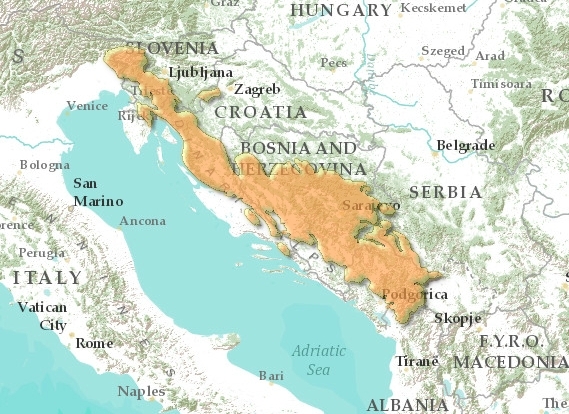 The Dinaric Mountain range spans several countries of Eastern Europe and is covered by mixed forest with an outstanding variety of deciduous oak trees. These forests are among the largest and most continuous tracts of forested habitat remaining for large carnivores in Europe. The flora has a relatively high endemism rate with many relict and restricted range species. Faunal diversity is high, and a number of IBAs (Important Bird Areas) and threatened SPECs (Species of European Concern) are encompassed within the region. Human impact remains high in this ecoregion, mainly due to the socio-economic and political instability of most countries in the region, where illegal logging, illegal hunting, and uncontrolled plant harvesting have recently destroyed extensive forest areas that had remained virtually untouched until current times.
The Dinaric Mountain range spans several countries of Eastern Europe and is covered by mixed forest with an outstanding variety of deciduous oak trees. These forests are among the largest and most continuous tracts of forested habitat remaining for large carnivores in Europe. The flora has a relatively high endemism rate with many relict and restricted range species. Faunal diversity is high, and a number of IBAs (Important Bird Areas) and threatened SPECs (Species of European Concern) are encompassed within the region. Human impact remains high in this ecoregion, mainly due to the socio-economic and political instability of most countries in the region, where illegal logging, illegal hunting, and uncontrolled plant harvesting have recently destroyed extensive forest areas that had remained virtually untouched until current times.
The mountain ranges of this region have had low human populations, and tall forests still prevail widely throughout. A significant number of pristine large forest stands remained quite untouched until very recently. Rapid and intense forest degradation in the form of illegal logging, pollution, and fire took place during the recent Balkan conflicts that led to the division of the Former Yugoslavia into a number of independent republics. Overexploitation of forests is ongoing in certain areas due to the political instability of most countries in the ecoregion.
See also:
- Status and distribution of reptiles and amphibians of the Mediterranean Basin
- Value of Mediterranean forests
Context
Ecoregions are areas that:
[1] Share a large majority of their species and ecological dynamics;
[2] Share similar environmental conditions; and,
[3] Interact ecologically in ways that are critical for their long-term persistence.
Scientists at the World Wildlife Fund (WWF), have established a classification system that divides the world in 867 terrestrial ecoregions, 426 freshwater ecoregions and 229 marine ecoregions that reflect the distribution of a broad range of fauna and flora across the entire Earth.
References
- Horvat, S. 1957. Pflanzengeographische Gliederung des Karstes Kroatiens und der angrenzenden Gebiete Jugoslawiens. Acta bot. croat. 16.
- IUCN. 1996. 1996 IUCN Red List of Threatened Animals. IUCN, Publication Service Unit, Cambridge. ISBN: 2831703352
- Krause, W. et al. 1963. Zur Kenntnis der Flora und Vegetation auf Serpentinstandorten des Balkans. 6. Vegetationsstudien in der Umgebung von Mantoudi. Euböa. Bot. jb. 82.
- Mayer, H. 1984. Wälder Europas. Gustav Fisher Verlag, Stuttgart.
- Water, K.S., and Gillett, H.J., editors. 1998. 1997 IUCN Red List of Threatened Plants. Compiled by WCMC. IUCN, Publication Service Unit, Cambridge.
- WWF. 2001. The Mediterranean forests. A new conservation strategy. WWF, MedPO, Rome.
